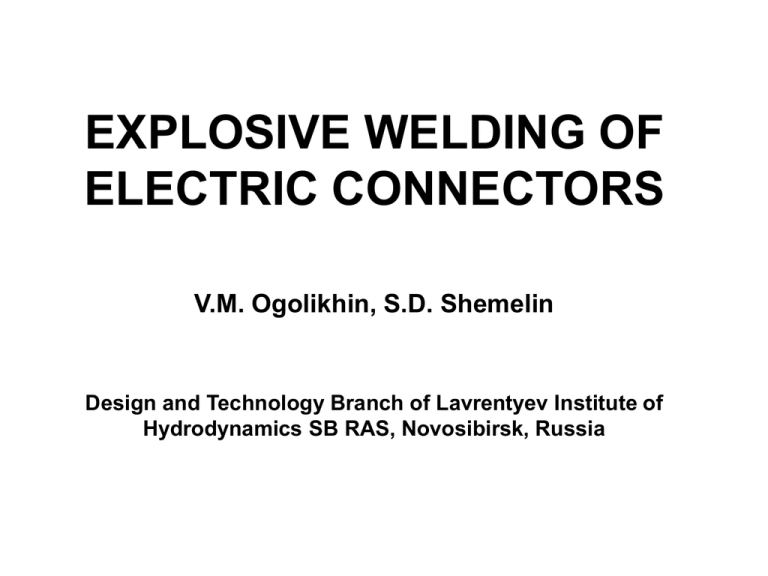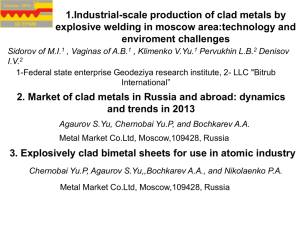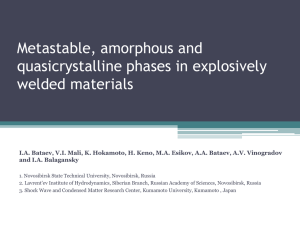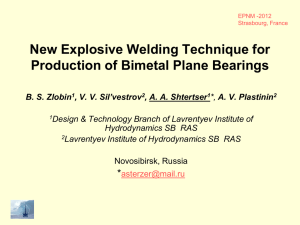V. Ogolokhin, S. Shemelin.
advertisement

EXPLOSIVE WELDING OF ELECTRIC CONNECTORS V.M. Ogolikhin, S.D. Shemelin Design and Technology Branch of Lavrentyev Institute of Hydrodynamics SB RAS, Novosibirsk, Russia Statement of Problem There is the problem of energy losses in electric power circuits, exploited in enterprises of power engineering (electric power stations, distributive facilities, transforming stations, etc.) and electrometallurgy (aluminum electrolyzers, remelting equipment, etc.). This problem to a considerable degree can be solved by reducing of transient resistance of electric contacts, where current leads made from different materials are joint together. Normally current leads are made of Cu or Al, and their joints are subjected to electrochemical corrosion, which causes the rise of electric resistance. Decrease of transient resistance can be achieved by use of special connectors, made with the help of explosive welding. In this presentation the explosive welding technique, developed for producing of Al -Cu connectors, is described. Current lead connectors can be used, when laying the electric power circuits at plants of nonferrous metallurgy and power engineering. Current lead used in electrometallurgy usually consists of a great number of flexible metal (Al or Cu) bands, assembled into one packet. The approach consist in explosive welding of packet end with transition element (connector) made of the same or different material. Further joining of current leads is provided through these connectors. 1 – packet of bands; 2 – connector; 3 – connector contact surface; 4 – flexible metal bands; 5 – welding zone between bands; 6 – connector plate; 7 – welding zone between bands and connector plate. Fig. 1 - General view of the flexible current lead Connection of current leads Fig. 2 - Flexible Current Lead (cut along) The left bus consists of 20 copper bands, the right bus – of 20 aluminum bands Fig. 3 – Explosive welding layout. Top view 1 – packet of bands; 6 – flyer plate; 10 – band open surface; 12 – detonator Fig. 4 – Section А-А of Fig. 3 4 – flexible metal bands (assembled with regular shift); 6 – flyer plate; 8 – shifted part of band; 9 – packet slant; 11 – high explosive; Δl – shift step. Fig. 5 – Symmetric explosive welding layout. 4 – flexible metal bands; 6 – flyer plate; 8 –shifted part of band; 9 – slant line; 10 – band weld area; 11 – high explosive; 12 – detonator; 13 – symmetry plane. Fig. 6 – The packet with milled end faces 4 – flexible metal bands; 6 – flyer plate; 9 – band packet slant line; 11 – explosive; 12 – detonator; 13 – symmetry plane; 14 – spacing. Arrows mean that packet is clipped. Fig. 7– The packet with the weld - preventing interlayers 4 – flexible metal bands; 6 – flyer plate; 9 – slant line; 10 – band weld area; 11 – explosive; 12 – detonator; 13 – symmetry axis; 15 - weld - preventing material; 16 – margin areas of bands. Fig. 8 – Aluminum band packets, welded with copper plates Number of flexible bands is 74 pcs. Conclusions 1. The proposed design of the flexible current lead enables to reduce significantly the electric-current losses on the internal and external contacts of the current lead. Current lead connectors can work at temperature up to 500 ˚С. 2. The proposed explosive welding technique permits to bond the connector plate with flexible metal bands, and simultaneously to weld the adjacent bands each with another over their end areas.







